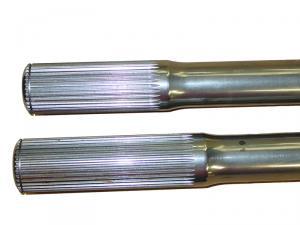I have the 'x type' 10mm longer axles and flanges from hytuff in the back of my 90 which are running oil lubed and I am not totally happy with them.
They already have a noticeable amount of slack (compared to when they were fitted) in the splines between the axle and flange.
I am hoping they dont get any worse but I am fully expecting one to fail at some point.
Admitedly the car gets hammered but they have only been in for about 20k km or so.
What evidence do you have that reducing necking down the axles will reduce stress/fatigue in ring and pinions???
I agree it wouldn't be much more expensive - however the big question is would it make a difference to the life of any components in practical terms?
Honing/polishing to improve the finish would be expensive though:

Hey Guys,
Very interesting this topic and certainly it is good information to learn with, this info is straight from the ashcroft web site....
All our heavy duty halfshafts carry a 5 YEAR breakage warranty
We manufacture three types of heavy duty halfshaft to fit the front and rear axles of the Range Rover, Discovery and 90. We also supply shafts to fit the late type (2003 onward,) 110 rear axle. Our shafts are made from '4340' alloy steel. We have also made some design improvements to remove the stress concentration which typically causes failure at the diff end, this allows the shaft to flex along its length absorbing much of the shock loads.
We are interested in 3 things :
1) torque applied, 2) total twist, 3) Elasticity,
The graphs below show the results of the testing we have done on the front and rear landrover halfshafts.

[QUOTE=isuzurover;1528698]What evidence do you have that reducing necking down the axles will reduce stress/fatigue in ring and pinions???
Ben,I can't believe you asked that question.Tell you what. Just between you and me, If you want to delete it, I'll do the same on this reply.
One doesn't need to be a rocket scientist to work out that a shaft that can flex to absorb shock loadings, such as when a spinning wheel suddenly finds traction, will also reduce the impact shock on the rest of the drive train that is supplying torque to that shaft. It's similar in a way to how the spring loaded slipping clutch on a tractor mounted slasher protects the driveline when the blades strike a hidden rock or tree stump. Or why the flexible torsion bars on my Holden Jackaroo prevent me and the rest of the vehicle from disintegrating when the front wheels strike a bump.
As I mentioned earlier, the finish on Daves shafts is probably good enough without requiring honing and polishing. After all, the torsion bars on the jackaroo weren't polished and live in an unfriendly environment, and they've flexed millions of times in their 400.000 km lifetime.
Wagoo.
I also have Keiths (Rovertracks) axles and Cvs in the front of my 110 and run 35's and certainly don't take it easy,and I can't fault mine either.I have already twisted a set of Maxi rear axles and flogged out a set of rear drive flanges.I now have a set of Hi Tuff axles and flanges,so will be interested to see how they last.When I had my axles and diff centre out,we checked the housing and it is straight.
Wayne
Wayne
VK2VRC
"LandRover" What the Japanese aspire to be
Taking the road less travelled
'01 130 dualcab HCPU locked and loaded
LowRange 116.76:1
| Search AULRO.com ONLY! |
Search All the Web! |
|---|
|
|
|
Bookmarks